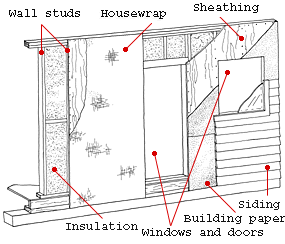Home > House Structure > Walls
Walls
Walls in houses are vertical structures that enclose and divide the interior space of a building. They serve as barriers and separations between rooms, providing privacy, defining areas, and supporting the overall structure. Walls are typically constructed using materials such as concrete, bricks, wood, or drywall, depending on the building's design and construction methods.
Usage and benefits of walls:
I. Structural Support: Walls play a crucial role in providing structural support to a building. They bear the weight of the roof and upper floors, transferring it to the foundation. Walls are typically made of strong and durable materials like concrete, bricks, or steel, ensuring the stability and safety of the entire structure.
II. Privacy and Security: Walls create separate spaces within a building, offering privacy to its occupants. They form barriers that prevent unauthorized access and ensure the security of individuals and their belongings. Walls also act as a psychological boundary, providing a sense of personal space and comfort.
III. Space Division and Organization: Walls are essential for dividing a building into different rooms and areas. This allows for efficient space utilization and organization, enabling specific functions to be carried out in designated areas. Walls also help in defining the flow and circulation within a building, ensuring smooth movement between different spaces.
IV. Noise Reduction: Walls contribute to sound insulation by blocking or absorbing sound waves. They help to reduce noise transmission between rooms, creating quieter and more peaceful environments. This is especially important in residential buildings, offices, and public spaces where noise control is necessary for comfort and productivity.
V. Thermal Insulation: Properly insulated walls play a crucial role in maintaining a comfortable indoor environment and reducing energy consumption. Insulation materials, such as foam, fiberglass, or cellulose, can be installed within the wall cavities to prevent heat transfer. This helps to retain warmth during colder months and keep the interior cool during hot weather, reducing the reliance on heating and cooling systems.
VI.Visual Appeal and Aesthetics: Walls are an integral part of interior and exterior design. They can be finished with various materials, such as paint, wallpaper, tiles, or natural stone, to enhance the overall aesthetics of a space. Walls can also be used as a backdrop for artwork, photographs, or decorative elements, adding visual interest and personal style to the environment.
VII. Durability and Longevity: Well-constructed walls contribute to the overall durability and longevity of a building. They protect the interior from external elements, including weather conditions, pests, and dust. Proper maintenance and periodic inspections of walls can help identify any potential issues, ensuring their longevity and preventing damage to the structure.
Walls serve as fundamental elements in building construction, providing structural support, privacy, security, space division, noise reduction, thermal insulation, aesthetics, and durability. They are versatile components that contribute to the functionality, comfort, and longevity of a structure.










